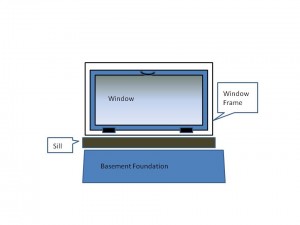 Depending on the age of your home and your location, you might have windows in your basement. Frankly, for most people, windows in the basement are an after-thought unless someone locks himself out of the house or there’s an accident with a baseball or you have a flood and need to get ventilation into the basement to help with drying things out.
Depending on the age of your home and your location, you might have windows in your basement. Frankly, for most people, windows in the basement are an after-thought unless someone locks himself out of the house or there’s an accident with a baseball or you have a flood and need to get ventilation into the basement to help with drying things out.
THEN, you’ll remember the windows in the basement.
On the other hand, when it comes to losing energy, basement windows are basically horrible. In general, they fit so badly into the sill on top of the foundation (a topic we have discussed before), are usually of the awning type and close and seal poorly so they are a major contributor to energy loss in a home. People are very very cognizant of replacing windows and doors in the living spaces of homes, insulating in walls and attics but the basement is Terra Incognita as far as energy savings is concerned which is really a mistake.
Now, one of the things to remember about this time of the year (winter in the Northern Hemisphere) is that doing any sort of energy saving work from the outside is practically worthless. Sealants such as caulk or foam need 55 degree temperatures to stick and cure. So, you will be needing to work from the inside and with any luck, your basement is 55 degrees. If it is NOT, then the technologies that you can put to work becomes more limited.
There are basically two items in the equation of losing energy with a basement window: The window itself which includes the frame in which the window is installed, and the sill. Whenever you have two independent materials coming together or laying on top of one another, you have opportunities for energy loss. The sill is on top of the foundation, so there can be energy loss between those. The window frame sits on top of the sill and is surrounded by the rest of the foundation so there are opportunities for heat loss there as well. Between the window itself and the frame can be cracks and crevices which can leak energy. And we won’t even discuss whether or not there are cracks in the window or if the caulking around the glass pane (or panes) is old, chipped, or cracked which would further increase the air exchange.
If you have a warm basement, you’ll be able to use silicone caulk and a caulking gun (or expandable foam) between the foundation and the sill and the sill and the window frame (see the diagram at the top). If you do NOT have a warm basement, then what you can do is (while wearing gloves), tear off bits of fiberglass insulating batting and with a thin bladed knife or putty knife, cram as much of it as you can between the foundation and the sill and the sill and the window frame, all around the window. This will take care of that part of the equation.
For the window itself, at this point in the year (since you can’t take the window out to do any repairs until spring), the best thing to do is to seal it off with heavy plastic. Now, the quick and dirty (and not terribly efficient) way to do it is to close up the window as tightly as it will go and then staple heavy plastic around the frame. If you want this to be more energy efficient, cut lengths of wood lathe and using a staple gun, staple through the lathe and the plastic into the frame. In the spring, you will have the job to tear off the lathe and the plastic but it does give a better seal.
A better insulation job, though can be done later if you do one thing: Anything you get shipped to you that is wrapped in bubblewrap (the bigger the better in terms of bubble size), as long as the piece is as big as the window frame, keep it. Just shove it into a plastic bag and hang it in a closet. Then late next fall, when it’s time to seal up the basement windows again, do the following:
1) Examine the windows and repair any window caulk, broken glass and so on.
2) Make sure there are no leaks around the window frame and the sill and foundation and re-caulk or re-foam as necessary.
3) Use the bubblewrap instead of plain heavy duty plastic or, tape together a layer of bubblewrap and heavy plastic the size of the space you need to seal off and staple THAT unit to the window frame. Bubblewrap produces a superior job in terms of acting as a barrier against heat loss through the window glass and it’s worth it. The plastic usually only lasts through one winter season but it’s worth saving the bubblewrap to do it.
Now, some readers might be saying to themselves, “This is madness. It’s winter already; how much energy can I save at this point by doing this?”
Every little bit counts, folks.

I haven’t tried it myself, but my sister swears by bubblewrap as a cheap form of doubleglazing. They used it in all the empty rooms of the old farmhouse they live in last winter and it made a noticeable difference in just a few days. We’ll be using it this winter too.